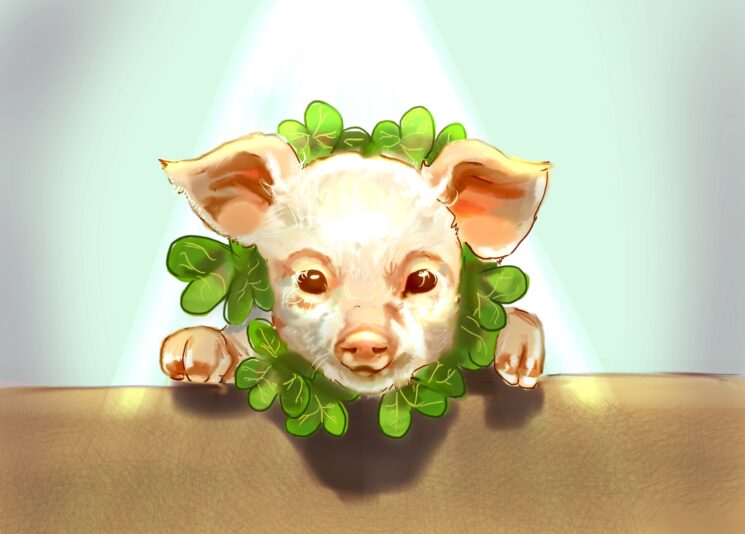
By Hannah Park
“Oooh, seven! My lucky number!”
“Stop! Don’t walk under that ladder!”
“I could have sworn that clover had four leaves! Oh, I wish I could find one… Just once in my life…”
Luck. Good luck. Bad luck. What is luck, anyway?
According to Merriam-Webster, luck is a “force that brings good fortune or adversity.” It’s the force we attribute to lottery wins and curse when we get the short end of the stick. Most of us have had lucky bracelets or deliberated over whether we should re-send that text message saying, “Send this to 10 people or else…”
But are the things we associate with good fortune the same around the world? What have different cultures found lucky, and what do these symbols reveal about their beliefs?
United States of America
Let’s highlight the little green leaves that Americans—and nearly everyone else in the world—find so charming. If you’re hoping to find a four-leaf clover soon, though, you might have to search for a while. According to a survey conducted in 2017, only one in 5,000 clovers sport four leaves.
Of course, since America has long been known as a melting pot of cultures, there’s no surprise that one of our most cherished luck symbols has Celtic roots. The four leaves represent faith, hope, love, and luck… and Celtic priests even believed that the special fourth leaf would allow one to see demons.
Well, why are they so rare? Genetically, clovers are a weird bunch. According to Science Focus, they have four copies of each chromosome, while humans only have two (one from each parent!). In order to have four leaves, a clover needs to have the four-leaf gene on all four chromosomes*.
*For the biology fans: This is because the allele, or gene variant, is recessive.
Ireland
Hang on, why didn’t we mention four-leaf clovers here? It turns out that shamrocks, three-leaf clovers that represent the Holy Trinity, are classic Irish symbols… but not four-leaf clovers. Four-leaf clovers are touted by a variety of cultures, including the United States.
Horseshoes, however, definitely have Irish origins. Legend says the devil once asked a blacksmith—also associated with luck—to give him shoes for his hooved feet. But the blacksmith tricked him by nailing red-hot irons to his feet!
Hang a horseshoe over your door, they say, and the devil will steer clear of your home. Hanging it “heels up” will allow you to collect buckets of luck.
Vietnam
One famous Vietnamese superstition centers around Tết Nguyên Đán (known as Tết for short), or Vietnamese Lunar New Year. Never sweep your house or take out the trash during the first three days of the new year!
Vietnamese households believe that if you do, you will end up sweeping out all of your good luck and fortune for the year. Therefore, families generally clean their houses before Tết.
In order to increase good luck, families give “lucky money” to their children in red envelopes. Interestingly, red is the color of luck in Eastern culture!
Latin America
Another good-luck tradition associated with the New Year is eating 12 grapes exactly at midnight. There’s a catch, though: you have to eat all 12 grapes in 12 seconds.
The tradition is relatively new, originating in Spain in the year 1909. It turns out that vineyards in Alicante, a city in Spain, were responsible for “las doce uvas de la suerte” (the 12 grapes of luck)! They wanted to sell more grapes after a large harvest and started this turbo-fast tradition.
Why exactly a dozen grapes? Each grape stands for good luck in each month of the year. But make sure you don’t shove them in your mouth all at once!
Korea
One unique luck symbol in Korea is the “pig dream,” or 돼지꿈. If you dream about a pig, especially one that’s trying to get into your home, it is a sign that wealth and good fortune are close at hand.
In the past, pork was eaten by the rich: it may have been the origin of this popular belief. People who receive a 돼지꿈 often rush out to buy lottery tickets or hope for job promotions or gifts.
And for people born in the year of the Pig*? They’re also associated with wealth. Pigs equal prosperity!
*The Year of the Pig is one of 12 repeating years in the Chinese zodiac calendar, used by many Asian cultures (Korea being one of them)! 2019, 2007, 1995, and 1983 were all Years of the Pig.
Israel/Middle East
The Hamsa is a unique symbol that both Jewish and Islamic cultures cherish. It looks like a hand with two thumbs and often features an eye in the middle.
Owners of Hamsa hand charms use them to scare away what is called the “evil eye.” It simply refers to angry or jealous stares that come from people around you; a Hamsa will protect you from any bad luck or unfortunate events that might follow these glares!
Since the Hamsa is deeply tied to religion, you might see the Star of David, fish, Jewish writings and other religious symbols engraved on these lovely hands.
Conclusion
Whether based on religion, traditions or folklore, every culture has its own ideas on how to maximize good fortune. And whether you believe in luck or not, there is a wealth of stories behind every symbol and tradition.
Dream of pigs, ward off evil glares, eat your grapes, hide your broom, hang your horseshoes and catch your clovers!
In other words… good luck!





